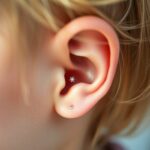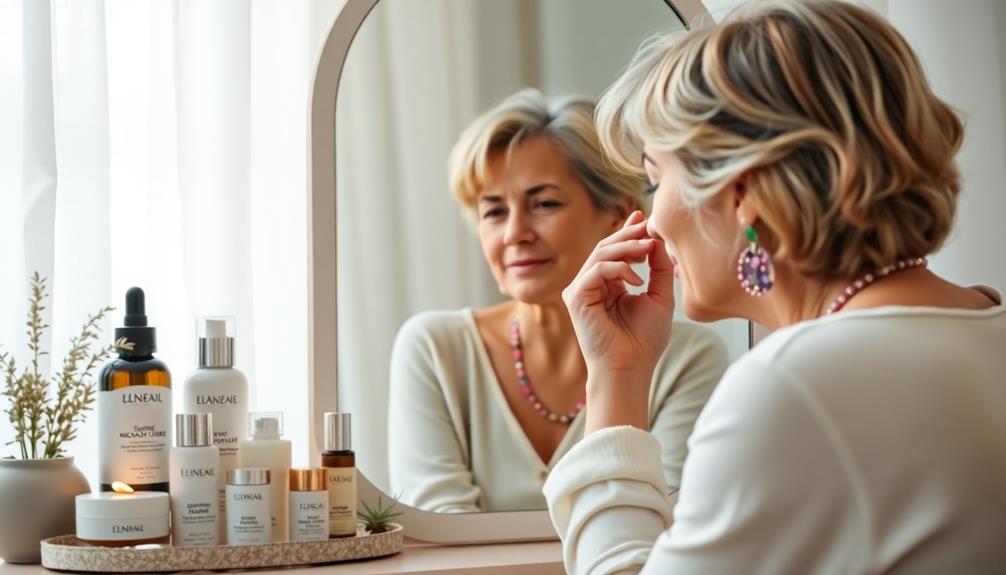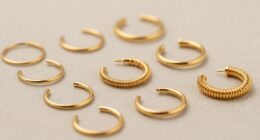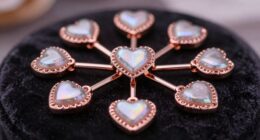When considering piercings for kids, it's important to know the age restrictions and guarantee you're involved in the decision-making process. Ear piercings can start as early as 2 months, while cartilage piercings are generally for kids aged 12 and up. Your child will need to be accompanied by you for any procedure, and many establishments require written consent. Discuss your child's motivations and assess their readiness before going ahead. Understanding the different methods, safety standards, and aftercare instructions will make the experience smoother for both of you. You'll find even more useful insights as you explore this topic further.
Key Takeaways
- Ear piercings can begin as early as 2 months old, but many studios accept children ages 4 to 6 for ear piercings.
- Minors under 18 require a parent or guardian present, along with written consent in certain states like New York.
- Licensed professionals should perform piercings using sterile equipment and hypoallergenic jewelry to reduce infection risks.
- Aftercare education is essential to prevent complications; proper cleaning and monitoring of the piercing sites are crucial.
- Cultural perspectives play a significant role in children's attitudes toward piercings, impacting their desire and parental decisions.
Age Requirements for Piercing

When considering piercings for kids, it's vital to understand the age requirements that vary by type and location. For ear piercings, you can start as early as 2 months old, but your child must have received at least one DTaP vaccine if they're 5 years or younger. This guarantees their health and safety during the procedure.
If you're thinking about cartilage piercings, keep in mind that they're generally available for kids aged 12 years and older in select establishments. It's important to check with the piercing studio, as they may have their own age policies.
Many places allow ear piercings for children ages four to six, so asking beforehand can save you time and confusion.
Also, don't forget that minors under 18 must have a parent or guardian present during the piercing. This requirement emphasizes your important role in the decision-making process.
Piercing Methods and Equipment

For parents considering piercings for their kids, understanding the various methods and equipment used is essential for guaranteeing a safe experience. The most common ear piercing method today involves a hand-pressurized device, which offers a gentler and more controlled process compared to traditional piercing guns. This method can be particularly beneficial for nervous children, as it minimizes discomfort.
To maintain hygiene and safety, sterilized single-use cartridges containing starter stud earrings are used during the procedure. This guarantees that no harmful bacteria are introduced during the ear piercing.
For younger children, lobe needle piercings can be performed as early as 5 years old, while cartilage piercings are typically available for those 12 and older at select locations.
In situations where a needle piercing isn't deemed safe, the device method is a reliable alternative, guaranteeing your child's safety is prioritized. Additionally, having multiple nurses available to pierce both ears at once can help reduce anxiety and streamline the process.
Piercing Process and Accommodations

Understanding the piercing process and available accommodations can help ease any concerns you or your child might have. Many piercing studios allow for both ears to be pierced at the same time, with multiple nurses available to assist. This makes the process quicker and more efficient, guaranteeing a smoother experience for everyone involved.
If your child feels nervous, they can postpone the second ear piercing without any penalty. This flexibility helps them feel more comfortable with the experience. To minimize wait times and guarantee availability, scheduling an appointment is highly recommended.
Here are a few key considerations regarding the piercing process:
- Parents or guardians need to provide valid identification, and local regulations may require children's IDs as well.
- The piercing is done using either a hand-pressurized device or a needle technique, guaranteeing safety and hygiene through the use of sterilized single-use cartridges.
- Understanding the process can help you reassure your child, making the experience less intimidating.
Jewelry and Aftercare

Once the piercing process is complete, it's vital to focus on the jewelry and aftercare to secure a smooth healing experience. For ear-piercing safety, using only sterile, nurse-provided earrings is imperative for new piercings. You can't use personal earrings initially to prevent infections. Healing times vary; lobe piercings typically heal in about 3 weeks, while cartilage piercings, like helix, conch, and tragus, can take around 12 weeks.
Proper aftercare includes sanitizing new jewelry before use and applying recommended products, such as hypochlorous ear piercing spray, for ideal healing. After the initial healing period, consider hypoallergenic options to avoid allergic reactions—steer clear of materials like nickel, brass, and zinc. Regular cleaning and monitoring of the piercing site are important to prevent infections and complications.
| Jewelry Type | Notes |
|---|---|
| Sterile Earrings | Required for new piercings |
| Hypoallergenic Options | Recommended after initial healing |
| Materials to Avoid | Nickel, brass, zinc |
Following these guidelines will help establish a positive experience for your child's new piercing.
Safety and Hygiene Standards

When it comes to piercing kids, safety and hygiene standards are paramount. You want to guarantee the environment is controlled and professional. Licensed nurses usually perform the piercings, which means they follow strict safety protocols that minimize risks.
Reputable establishments adhere to stringent sanitary practices, including sterilized equipment and single-use cartridges for each piercing. This is vital in reducing the chance of infection.
To keep your child safe and healthy during the piercing process, consider the following:
- Hypoallergenic earrings: Choose earrings made from premium materials to prevent allergic reactions.
- Proper training: Confirm that the professionals have extensive training in personal protective equipment (PPE) and sterility.
- Pediatrician recommendations: Consult with your child's doctor to find a safe piercing environment.
Legal Age and Consent

Maneuvering the legal age and consent requirements for kids' piercings can be a bit complex. In New York State, for instance, minors under 18 need written parental consent for ear piercings, as specified by public health laws. This means you'll need to be actively involved in the process to guarantee everything goes smoothly.
Most piercing establishments have their own age policies, typically allowing lobe piercings for kids as young as four to six years old.
When you go to get your child's piercing, be prepared to present a government-issued photo ID, like a driver's license or passport, alongside proof of your relationship to the child, such as a birth certificate. Establishments often require original documents to verify authenticity, similar to what you'd encounter in medical or legal settings.
Your role as a parent or guardian isn't just about consent; it's crucial for guiding your child through this decision. Your involvement helps prevent impulsive choices and guarantees that safe practices are followed during the piercing process.
Cultural Perspectives on Piercings

Piercings have deep cultural significance in many societies, often reflecting unique traditions and beliefs. When you consider cultural perspectives on piercings, you'll notice that body modification practices vary widely across the globe. In some cultures, such as Brazil and Nigeria, piercing infants is a common practice, deeply rooted in familial traditions. These customs symbolize rites of passage, identity, or beauty standards, showcasing the rich diversity of human expression.
In certain communities, piercings are embraced as art, representing creativity and individuality.
Conversely, some cultures view piercings negatively, associating them with rebellion or inappropriateness.
The normalization of piercings raises questions about autonomy, especially when it comes to infants or children.
Societal acceptance of piercings can also differ markedly. In many places, teenagers proudly express themselves through body art, while other societies might impose stricter views. This variance in attitudes highlights the importance of understanding cultural contexts when discussing piercings for kids.
Ultimately, recognizing these cultural perspectives can guide you in making informed choices about body modifications in your family.
Personal Experiences With Piercings

When you think about your own piercing journey, cultural influences probably come to mind.
Maybe a family member took you for your first earring, or you decided to express yourself with a unique stud as a teen.
Each choice reflects personal stories and motivations that shape your identity and confidence.
Cultural Influences on Piercing
Cultural influences shape how children perceive and experience piercings, often intertwining personal identity with family traditions. In many communities, ear piercings aren't just a fashion statement; they symbolize rites of passage and signify milestones in social identity. You might find that your child feels encouraged or even pressured by family members to adopt similar body modifications, reinforcing a sense of belonging.
Consider these aspects of cultural influences on piercings:
- In some cultures, infants as young as four months are pierced, reflecting deep-rooted beliefs about body modification.
- Celebrating body art can enhance social status, making piercings a way for children to connect with their heritage.
- The growing acceptance of piercings as self-expression encourages teenagers to explore individuality and artistic representation.
Understanding these cultural nuances can help you navigate the conversation around piercings with your child, balancing personal choice with family values.
Personal Stories and Motivations
Experiences with piercings often reveal the personal motivations that drive children and teenagers to modify their bodies. Many kids get their first piercings in infancy, influenced by cultural norms embraced by their families.
As they grow older, you might find that self-piercing at ages 14-16 becomes a significant act of self-expression. For many, it's a defining moment that boosts confidence and shapes personal identity.
Family members, particularly parents or legal guardians, play a huge role in these decisions. You may hear stories of young people inspired by their relatives' body art, which can spark a desire to embrace similar modifications.
The motivation behind these choices often stems from an artistic urge, as many feel that piercings enhance their individuality and style.
However, reflecting on these experiences, it's common for individuals to acknowledge the impulsiveness that sometimes accompanies getting multiple piercings.
It's essential to remember that thoughtful decision-making is key when considering body modifications. Engaging in open conversations with your parent or legal guardian can provide valuable insights, ensuring that the choice aligns with your personal values and aspirations.
Considerations for Tattoos and Piercings

When you're thinking about tattoos and piercings for your child, it's essential to assess the long-term impact of these choices.
Consider the importance of professional application to guarantee safety and quality, as well as your child's ability to care for their new modifications.
Weighing these factors will help you make a responsible decision that aligns with your family's values.
Long-term Impact Assessment
Making the decision to get tattoos or piercings involves careful thought about their long-term implications. Tattoos are permanent, and the regret that can come later may lead to costly removal procedures ranging from $50 to $250.
While getting your ears pierced is often seen as a rite of passage, even piercings can affect future job prospects. Some employers may have strict policies against visible body modifications, so consider your career path before diving in.
Additionally, it's important to think about how various investment options, like Gold IRA accounts, could play a role in your financial planning, especially when considering the long-term costs associated with body modifications.
Understanding the healing process is also essential. Lobe piercings take around three weeks to heal, while cartilage piercings require about twelve weeks. This time frame can help you assess your commitment to aftercare and maintenance.
Here are some key considerations to keep in mind:
- Regret and Removal: Tattoos can lead to long-term regret, prompting expensive removal.
- Career Impact: Visible piercings may hinder job opportunities in some fields.
- Cultural Norms: Societal attitudes towards body modifications can vary, influencing your decision.
Professional Application Importance
Guaranteeing that your piercings are done professionally can greatly impact your overall experience and safety. When it comes to getting a piercing, you'll want to choose a licensed professional who uses sterile techniques. This minimizes the risk of infection and complications, which is essential for a positive outcome.
Professionals rely on sterilized, single-use equipment and hypoallergenic materials to prevent allergic reactions and promote proper healing. Additionally, proper piercing care and hygiene is important in maintaining the health of the piercing after the procedure.
It's imperative to find a reputable establishment that adheres to strict health codes and sanitation practices. A clean environment for the piercing process is non-negotiable.
Additionally, experienced professionals can provide you with proper aftercare instructions, helping you monitor for any potential issues. If complications do arise, a trained individual can address them promptly, guaranteeing your peace of mind.
If you're considering piercings for your child, remember that you need parental consent. This not only guarantees that you're making informed decisions but also emphasizes the importance of choosing a professional setting.
Decision-Making Considerations
Deciding on a piercing for your child involves several important factors that require careful consideration. Before proceeding with needle piercings, think about your child's emotional readiness and maturity level. Proper aftercare is essential for healing, and a child aged four to six mightn't fully understand the responsibilities involved.
Additionally, just as with dental health, it's important to recognize that improper aftercare can lead to complications, including infections and long-term issues. Educating your child about the importance of maintaining hygiene can help prevent these risks, much like the significance of flossing for kids.
As a parent or guardian, it's important to discuss the reasons behind wanting new piercings. This conversation can help you gauge their motivations and confirm the decision isn't impulsive. Additionally, consider the potential long-term implications of visible piercings on future job prospects—some professions may have strict guidelines.
Here are some decision-making considerations to keep in mind:
- Choose a reputable, licensed professional piercer to minimize health risks.
- Educate yourself and your child about the healing process and aftercare requirements.
- Think about the societal perceptions associated with piercings and how they might affect your child.
Importance of Parental Involvement

When it comes to body modifications like piercings, parental involvement plays a critical role in guiding minors through the process. Since minors under 18 need parental consent for piercings, it's vital for you as a parent to actively participate in this decision.
By doing so, you guarantee that your child makes a responsible choice rather than an impulsive one, which could lead to complications or dissatisfaction later on.
Moreover, during the piercing process, identification is necessary for parents or guardians, reinforcing your supervisory role.
This policy helps protect your child from unauthorized decisions and potential health risks associated with body piercings.
Frequently Asked Questions
What Age Should You Let Your Child Get a Piercing?
You should consider your child's maturity and ability to follow aftercare instructions when deciding on an age for a piercing. Generally, ear lobe piercings are suitable around four to six years old. Always consult a pediatrician.
What Age to Let a Child Have Ears Pierced?
Is there ever a perfect age? While many recommend waiting until 4 to 6 years, you should consider your child's maturity. They'll need to handle aftercare responsibly, so think carefully before deciding.
Do You Need Your Parents' Permission to Get a Nose Piercing?
Yes, you need your parents' permission to get a nose piercing if you're under 18. It's important to discuss your desire with them first, as studios often require written consent and parental identification.
Can I Get a Piercing Under 16?
Imagine a key opening a treasure chest. If you're under 16, that key's in your parents' hands. You'll need their permission to explore the world of piercings, ensuring you're ready for the adventure.
Conclusion
In the end, when it comes to piercings for kids, it's all about balance—between expression and safety, freedom and responsibility. By understanding age restrictions, methods, and aftercare, you can guarantee a positive experience for your child. Remember, your involvement matters; it's not just about the piercing itself but the memories you create together. So, step into this journey hand in hand, and let your child shine while you guide them with love and care.















